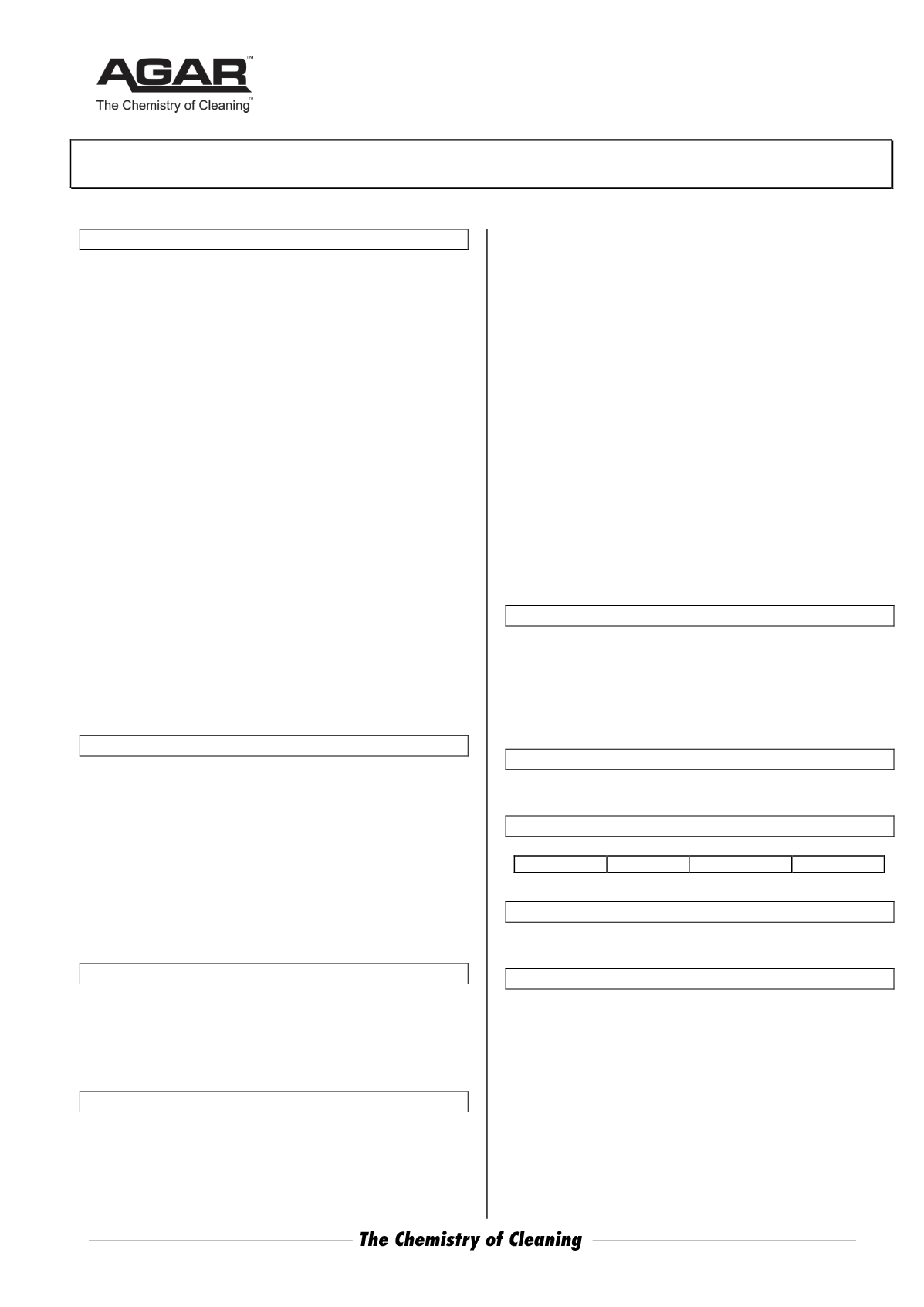

ABN 80 004 726 890 | MADE IN AUSTRALIA
Safety Data Sheet
Issued: December 18, 2015
Page 2 of 3
SHIFTER
8 EXPOSURE CONTROLS / PERSONAL PROTECTION
Exposure Standards: None assigned for mixture. Data for
principal ingredients only:
Atmospheric Contaminant Exposure Standard for:
2-butoxy ethanol: CAS No. 111-76-2
TWA = 20 ppm (96.9 mg/m3) ‘Skin’;
STEL = 50 ppm (242 mg/m3).
Sodium hydroxide : CAS No. 1310-73-2
TWA = - ppm (2 mg/cu.m) Peak limitation
STEL = -
Potassium hydroxide : CAS No. 1310-58-3
TWA = - ppm (2 mg/cu.m) Peak limitation
STEL = -
Ethanolamine: CAS No. 141-43-5
TWA = 3 ppm (7.5mg/m3)
STEL = 6 ppm (15 mg/m3).
[Source: Safe Work Australia HSIS 2015]
Engineering Controls: Mechanical Ventilation: Not required.
Personal Protection:
Gloves – Impervious natural rubber, butyl rubber, nitrile or
PVC gloves should be worn.
Note: Resistance of glove materials can vary. Evaluate
resistance under conditions of use and maintain PPE
carefully.
Eye-protection - Suitable eye/face protection should be worn.
Other - Protective overalls and boots are desirable. An
eyewash unit should be available.
9 PHYSICAL AND CHEMICAL PROPERTIES
Appearance: Opaque viscous orange liquid
Odour: Butyl odour
pH = 13 – 14
Vapour Pressure: N/K
Vapour Density: N/K
Boiling Point : 100ºC
Freezing Point: < 0
°
C
Solubility in water: Infinitely miscible
Specific Gravity : 1.13
Evaporation rate: As water
% Volatile by vol: <4% VOC
10 STABILITY AND REACTIVITY
Stable.
Do not store in aluminium or galvanised containers.
Hazardous polymerization: None.
11 TOXICOLOGICAL INFORMATION
Health Effects:
Acute –
Swallowed:
Corrosive to the gastro-intestinal tract if
swallowed.
Eye:
Corrosive and irritating to the eyes.
Skin:
Principal route of exposure is usually by skin contact.
One component may be absorbed by the skin and is capable
of causing skin reactions. Corrosive and irritating to the skin
on contact. Repeated or prolonged skin contact may cause
burns, swelling, blistering or dermatitis.
Inhalation:
Risk is low if product is used as directed, but
breathing of concentrated vapour should be avoided.
Health Effects:
Chronic -
None known.
Toxicity data: Not available for mixture.
2-butoxy ethanol: Acute oral (rat) LD50: 1480 mg/kg.
Inhalation (LC50) (mouse): 700 ppm/7hrs.
Sodium metasilicate: oral (rat) LD50: 1153 mg/kg.
Ethanolamine: oral (rat) LD50: 2050 mg/kg.
dermal (rabbit) LD50: 1000 mg/kg.
Sodium hydroxide: oral lowest lethal dose (rabbit):-
500 mg/kg (10% solution).
Potassium hydroxide: oral (rat) LD50: 273 mg/kg
(Note: this data is from published information. Agar Cleaning
Systems does not carry out animal tests).
12 ECOLOGICAL INFORMATION
Ecotoxicity: May cause pH shifts outside the range of 5-10
standard units. This change may be toxic to aquatic organisms.
Persistence and degradability: The surfactants in Shifter are
biodegradable.
Mobility: -
Advice: Prevent product from entering natural waterways.
13 DISPOSAL CONSIDERATIONS
For disposal, refer to State Land Waste Management Authority.
14 TRANSPORT INFORMATION
UN No.: 1719
Class: 8
Packg.Group: II Hazchem: 2R
15 REGULATORY INFORMATION
Poisons Schedule Number: Schedule 5.
16 OTHER INFORMATION
AICS Listing:
All components of Shifter are listed on the
Australian Inventory of Chemical Substances (AICS).
Please turn to Page 3.


















